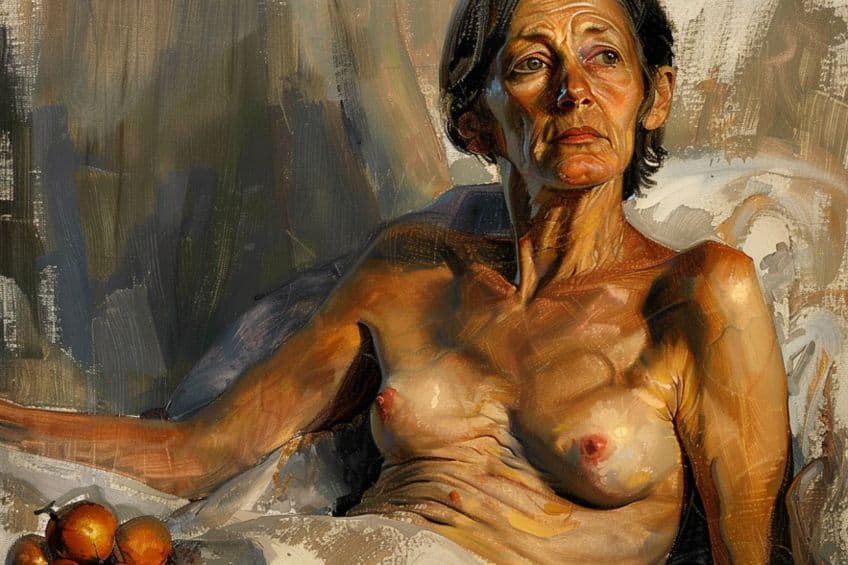“Irish Woman on a Bed” by Lucian Freud – A Painting Analysis
Lucian Freud’s Irish Woman on a Bed is a captivating exploration of intimacy and vulnerability, showcasing the artist’s signature style of raw, unflinching portraiture. Painted between 2003 and 2004, this masterpiece captures a moment of quiet contemplation and introspection, with the subject’s gaze drawing viewers into her world. Freud’s meticulous attention to detail and his ability to convey complex emotions through his subjects’ expressions make Irish Woman on a Bed a profound reflection on the human condition. Through this work, Freud invites us to delve into the inner world of his subjects, blurring the line between observer and observed.
Key Takeaways
- Irish Woman on a Bed showcases Lucian Freud’s raw and intimate portraiture style through oil on canvas.
- The painting, created between 2003 and 2004, continues to be recognized for its emotional depth and realistic representation.
- Freud’s work, including this piece, has been regularly exhibited and critically acclaimed for its contribution to contemporary figurative painting.
Context and Background of Irish Woman on a Bed
| Artist | Lucian Freud (1922 – 2011) |
| Date Created | 2003 – 2004 |
| Medium | Oil on canvas |
| Genre | Portraiture |
| Period/Movement | Expressionism |
| Dimensions (cm) | Unknown |
| Series/Versions | N/A |
| Where Is It Housed? | Private collection |
| Estimated Worth | Varies |
Irish Woman on a Bed is a notable painting by Lucian Freud, an acclaimed artist recognized for his contribution to portraiture and figurative painting. Created during the years 2003 to 2004, the work is executed in oil on canvas, which stands as a testament to Freud’s meticulous brushwork and intimate portrayal of his subjects. This piece depicts an Irish woman reclined on a bed, a subject and posture characteristic of Freud’s intimate yet raw style, revealing the psychological depth he would capture in his models.

Lucian Freud, born in 1922 in Berlin and a grandson of the famed psychoanalyst Sigmund Freud, moved to London in 1931 where he would later establish his career as a painter. His work often explored the complex relationship between the artist and the subject. Irish Woman on a Bed is reflective of Freud’s later works, which are marked by stark realism and an unflinching approach to the human form. Freud’s legacy is fortified through his consistent exhibition in prestigious galleries and the critical reception that often highlights the intense emotional encounter between his paintings and their viewers.
Lucian Freud’s Artistic Style
Lucian Freud, a renowned British painter, was known for his thickly impastoed portrait and figure paintings. His work often contained naked portraits of friends, family, and acquaintances. Freud’s application of paint was lush and laden with texture, where every brushstroke conveyed the physicality and emotion of the subject. Canvas was the foundation upon which he built his tactile works, the broad weave often adding to the sense of raw, exposed realness that his paintings exuded.
Evolution of Freud’s Portraitures
Throughout his career spanning over seven decades, Freud’s style evolved from the linear and surrealist-inspired works of his early years to the bold, visceral portraits of his later years. By 2004, the year depicting the creation of Irish Woman on a Bed, Freud had established his reputation for intimate and often unflattering depictions. His subjects, including notable figures like Leigh Bowery, were often shown with an uncompromising honesty.
Freud’s contribution to the art of portraiture lies in how he captured the essence of the person through the corporeal rendering on canvas, focusing on the texture and form of flesh.
Description and Analysis of the Painting
Irish Woman on a Bed is a work by Lucian Freud that presents a vivid and intimate representation of the human form. This section delves into the visual and textural intricacies of the painting, as well as the symbolism that underpins its interpretation.
Visual Composition
The painting depicts a woman lying on a bed, the composition placing her diagonally across the canvas which extends the perception of space. Freud’s use of perspective focuses on the presence of the figure in the room, evoking a sense of immediacy and proximity. The subject is positioned such that her form commands attention, illustrating Freud’s admiration for the grandeur and authenticity of the human body.
Color and Texture
Freud’s palette is often characterized by earthy, muted tones, and this painting is no exception. The use of color enhances the realism, with the skin tones appearing both palpable and varied. Texturally, Freud employs thick impasto to give a sense of depth and dimension.
The physicality of the strokes allows viewers to sense the artist’s direct engagement with the canvas, creating a tangible connection between the observer and the observed.
Symbolism and Interpretation
In Freud’s work, nudity is rendered with unflinching honesty, devoid of eroticism or idealization. Irish Woman on a Bed is aligned with this approach, where the nakedness serves as an exploration of the subject’s vulnerability and humanity. The painting resonates with Freud’s reputed theme of monumentality, not in size but in emotional gravity and psychological presence. As a portrait, it transcends mere likeness, becoming a profound expression of human existence.
Provenance and Exhibition History
The artwork Irish Woman on a Bed has made notable appearances in art exhibitions and is associated with distinguished collections. Tracking its journey from private collection to the public eye, this section details the painting’s exhibition history and provenance.

Acquavella Galleries Loan Exhibition
Irish Woman on a Bed was featured in a loan exhibition held by the Acquavella Galleries in New York. This exhibition showcased a selection of Lucian Freud’s works, emphasizing large-scale paintings from the latter part of his career
Inclusion in Public Collections
While Irish Woman on a Bed has predominantly been part of private collections, including the notable Lewis Collection, its importance can often lead to loans for public exhibition. Representatives of public collections such as the Metropolitan Museum of Art and the Art Institute of Chicago actively participate in securing significant works for temporary displays. However, there’s no concrete record of permanent acquisition by such institutions at this time.
The painting’s exhibition in esteemed venues and its presence in prominent collections underscore its relevance in contemporary art discussions.
Impact and Critical Reception
Lucian Freud’s Irish Woman on a Bed has had a notable impact on the art world, recognized for its contribution to contemporary artistic influence and the way it has been received by both the public and critics.
Contemporary Artistic Influence
The work of Lucian Freud, particularly his large-scale portraits such as Irish Woman on a Bed, has been influential among contemporary artists. Freud’s assistant, David Dawson, has been both a subject of Freud’s work and an observer of his methods, potentially carrying Freud’s influences into his own artistic practices.
The emphasis on raw and intimate depictions of the human form that characterizes Freud’s portraits, “Irish Woman on a Bed” included, has helped to solidify a deeper appreciation for the unvarnished human subject in modern art.
Public and Critical Response
Irish Woman on a Bed has garnered attention for its inclusion in selective public collections and notable exhibitions. For instance, the painting has made its rounds in various public exhibitions, allowing viewers to witness Freud’s work up close. This exposure contributes to the painting’s standing within both public and academic circles. Although specific critical responses to Irish Woman on a Bed are not detailed here, Freud’s work has historically oscillated between praise for its unflinching realism and critiques of its stark, often deemed unflattering, portrayal of subjects.
Additionally, the painting’s inclusion in high-profile events, such as an exhibition in Palm Beach, underlines its significance within both market and scholarly realms, reinforcing its impact on the art scene. Public and critics alike tend to acknowledge Freud’s influence and unique style, with his paintings, including Irish Woman on a Bed , holding substantial sway in discussions of late 20th and early 21st-century art.
Lucian Freud’s Irish Woman on a Bed stands as a testament to his mastery of portraiture and his unique ability to capture the essence of human emotion. Through his meticulous attention to detail and his profound understanding of the human psyche, Freud invites viewers to engage with the inner lives of his subjects in a deeply personal way. Irish Woman on a Bed not only showcases Freud’s technical skill but also his empathetic approach to portraiture, making it a timeless and compelling artwork that continues to resonate with audiences worldwide.
Frequently Asked Questions
What Is the Artistic Style and Techniques Used by Lucian Freud in Irish Woman on a Bed?
Lucian Freud employed a hyper-realistic style in Irish Woman on a Bed, often characterized by thick impasto brushwork and a restrained color palette. The tactile quality of his work is achieved through the layering of oil paint, resulting in a three-dimensional effect that lends gravity and presence to the figure depicted.
What Is the Significance of the Irish Woman on a Bed in Lucian Freud’s Body of Work?
Irish Woman on a Bed is a significant piece in Freud’s oeuvre as it exemplifies his intense focus on human subjects and their form. This painting, created between 2003 and 2004, contributes to Freud’s reputation as a master of portraiture who delved deeply into the physical and psychological presence of his sitters.
How Does Irish Woman on a Bed by Lucian Freud Reflect the Artist’s Perception of His Subject?
Freud’s Irish Woman on a Bed showcases the artist’s perception of his subject with unflinching honesty. Rather than idealizing his model, Freud portrays them with stark realism, reflecting his commitment to depicting the human body candidly, complete with its imperfections and vulnerability.
What Are Some of the Major Themes Explored in Lucian Freud’s Irish Woman on a Bed?
Major themes in Irish Woman on a Bed include introspection, isolation, and the human condition. Freud’s portrayal often emphasizes the psychological state of his subjects, encouraging viewers to contemplate the internal life of the individual he has rendered on canvas. The intimate setting and the thoughtful pose of the woman further intensify the painting’s thematic explorations.
Isabella studied at the University of Cape Town in South Africa and graduated with a Bachelor of Arts majoring in English Literature & Language and Psychology. Throughout her undergraduate years, she took Art History as an additional subject and absolutely loved it. Building on from her art history knowledge that began in high school, art has always been a particular area of fascination for her. From learning about artworks previously unknown to her, or sharpening her existing understanding of specific works, the ability to continue learning within this interesting sphere excites her greatly.
Her focal points of interest in art history encompass profiling specific artists and art movements, as it is these areas where she is able to really dig deep into the rich narrative of the art world. Additionally, she particularly enjoys exploring the different artistic styles of the 20th century, as well as the important impact that female artists have had on the development of art history.
Learn more about Isabella Meyer and the Art in Context Team.
Cite this Article
Isabella, Meyer, ““Irish Woman on a Bed” by Lucian Freud – A Painting Analysis.” Art in Context. May 23, 2024. URL: https://artincontext.org/irish-woman-on-a-bed-by-lucian-freud/
Meyer, I. (2024, 23 May). “Irish Woman on a Bed” by Lucian Freud – A Painting Analysis. Art in Context. https://artincontext.org/irish-woman-on-a-bed-by-lucian-freud/
Meyer, Isabella. ““Irish Woman on a Bed” by Lucian Freud – A Painting Analysis.” Art in Context, May 23, 2024. https://artincontext.org/irish-woman-on-a-bed-by-lucian-freud/.












Why are you showing a completely different painting at the top of this page which is not even by Freud?
Hi Patrick, due to copyright, we are not allowed to show the actual artwork.